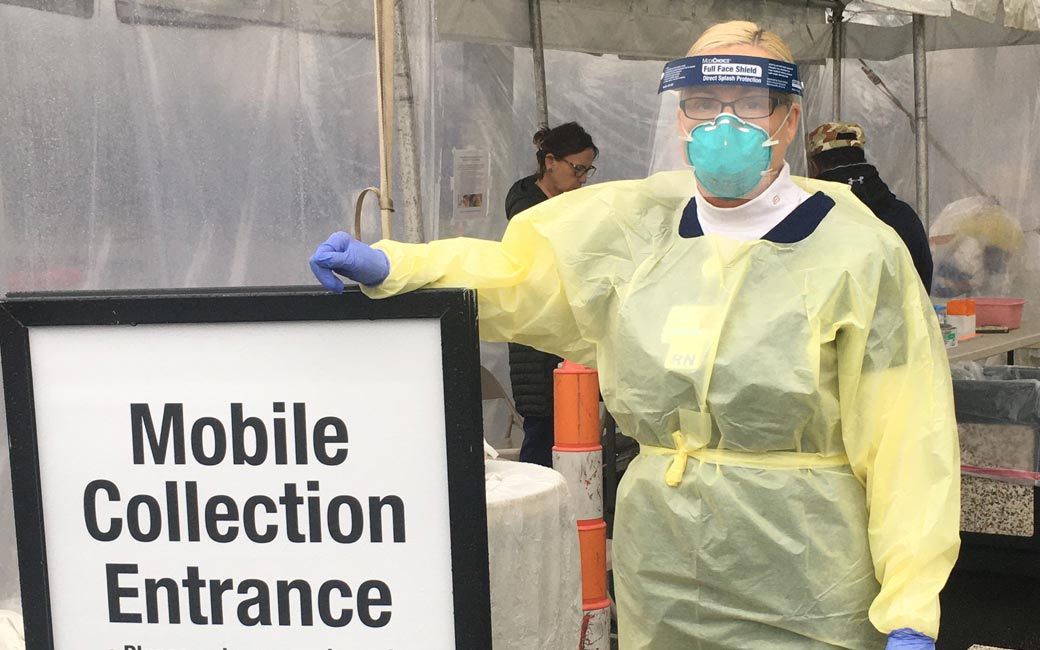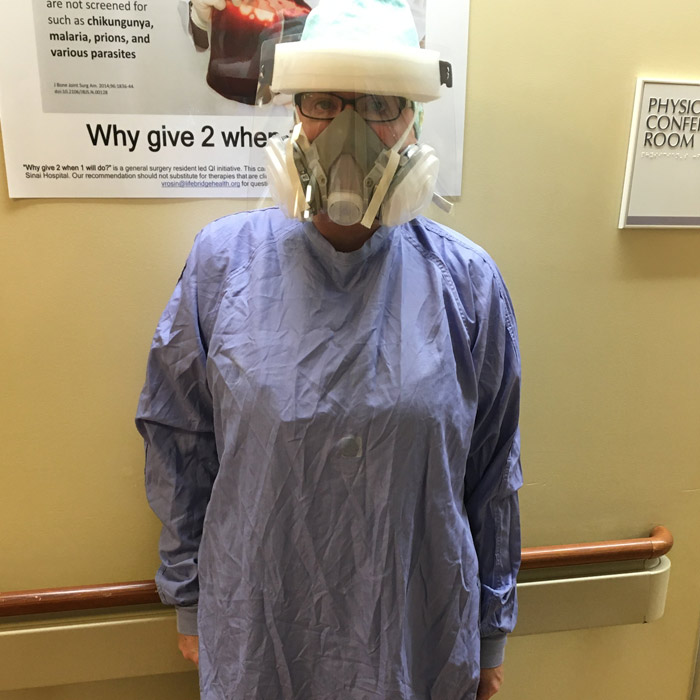TU nursing faculty balance teaching, treating COVID patients
Many work in hospitals, bringing practical experience to their students
By Cody Boteler on June 9, 2020

The Towson University faculty brings practical experience and personal stories to students, in addition to theoretical knowledge.
This is especially true in the College of Health Professions’ Department of Nursing, where multiple faculty members are also working as bedside nurses during the COVID-19 pandemic.
“It’s wonderful that we have faculty who can both work in clinical settings and teach. I’m grateful for that,” says department chair Hayley Mark. “The faculty are very current in their clinical skills, which they bring to the classroom.”
The outcome of having such incredible nursing faculty is clear: Towson University is the largest provider of healthcare professionals in Maryland, and students in the nursing program have a 90% pass rate on the National Council Licensure Exam.
Meet three full-time faculty members working on the front lines of the COVID-19 pandemic.
‘The value is tremendous’
Teresa Nikstaitis is a clinical assistant professor at TU, a critical care nurse in the intensive care unit at Sinai Hospital in Northwest Baltimore and a captain in the Maryland Defense Force.
In the latter role, Nikstaitis screened hundreds of members of the Maryland National Guard for COVID-19 before they deployed for active duty. At Sinai, she’s been treating patients with the disease and screening patients as they come in to the hospital.
“When I first knew I was going to be around COVID-19 patients, I said, ‘you know what? I know what I need to do. I know how to protect myself,’” Nikstaitis says.
Students tell her that hearing stories from her current work is a benefit; nursing students appreciate Nikstaitis’ honesty and her “telling them what’s really out there in a hospital.”

That’s especially true as nursing students graduate into a world changed by a pandemic.
“The value is tremendous. Students hear about what’s going on, and they know they’re going to be there soon,” Nikstaitis says. “You can’t get this out of a textbook. It’s like your grandmother sitting there when you’re a kid, telling you stories. It’s valuable; it’s meaningful.”
‘I just love what I do’
Renada Gilliard has wanted to be a nurse since she was a child. After she got her master’s degree, people were surprised to hear she still wanted to work in a clinical setting.
“I’ve always had that drive for helping people,” she says. “I have to have my hands on a patient. I have to. I just love what I do.”
Gilliard has been working at GBMC Healthcare for 21 years and enjoys seeing former students become colleagues at the hospital.
They’ve told her that keeping her clinical skills sharp is an asset in the classroom.
“Health care is changing all the time. I’m right there, hands on, so I can teach students the lived experience,” she says.
‘Living proof’
Nursing department assistant chair Regina Twigg knows that COVID-19 is a tricky disease: She and her husband have both recovered from it.
“It is a hard virus, no lie,” Twigg, who was diagnosed on March 30 and was cleared April 12, says. “But I am living proof that people recover.”
TU started spring break early on March 11, and then transitioned to distance learning. From the time she tested positive, Twigg hasn’t returned to campus and has taught from home.
"That's the beauty of being remote," she says. "You can be online and answer questions."
Twigg, who also works at the R Adams Cowley Shock Trauma Center, has regularly talked with students getting ready to graduate.
They talk about how their job prospects might be changing or how to prepare themselves for exposure in the health care field. Twigg studies history to help students understand the time that they find themselves in now.
She compares the current outbreak to MRSA, a difficult-to-treat bacteria that emerged in the 1990s. Professionals studied the disease and have a firmer grasp on how to treat and prevent spread of it now.
“Sharing what I’ve learned helps students understand that, the longer you stay in health care, the more you’re going to be exposed to and learn about,” Twigg says. “But the more knowledgeable you are, the less you fear.”
Twigg enjoys being honest with her students and preparing them for a career in health care. She knows all her students by their first names.
“I was used to teaching in a classroom of 150 (at another institution). I very rarely have more than 40 or 50 in my class. I feel like that’s very fortunate,” Twigg says. “I love TU students’ energy, their passion, their inquisitive nature.”
The faculty members on the frontline are not the only members of the TU community serving the region during the pandemic. Multiple departments have donated supplies and personal protective equipment, the TUPD has delivered food to health care workers and some nursing students have exited early in order to get to work faster.
There have been creative endeavors to spread joy, including a collection of GIFs, a chorale performance and chalk artwork. See more on how the Towson University community has responded with #TUtogether.[BROKEN LINK]
For the TU nursing faculty, all the work is worth it because of the impact it has on the students.
“It’s really amazing, being with the students,” Nikstaitis says. “Seeing those ‘ah-ha!’ moments and watching them grow.”
This story is one of several related to President Kim Schatzel’s priorities for Towson University: TU Matters to Maryland and BTU-Partnerships at Work for Greater Baltimore.